The Shiva temple of Pashupatinath in Kathmandu is popular with tourists as well as devoted Hindus – and – with mourners who come there to cremate their family members. This combination sets the scene for a bizarre experience on the banks of the Bagmati River.
Just as we arrived, a self proclaimed guide reared his head from behind the ticket office.
– “Come with me, I’ll show you where they burn human bodies”, he said.
At a slightly less than culturally sensitive distance the gentleman, or perhaps I should say man, informed us about the specifics of cremation and why the woman, whom was close enough too to reach out and touch, was crying her heart out.
Just as a cloud of ashes from the remnants of a nearby funeral pyre rose into the air, we backed off. This view was somewhat more eccentric than anticipated and we also nurtured a sneaking suspicion this couldn’t be entirely right.
The guide begged to differ though – and In time a morbid curiosity snuck upon us. From the far side of the river we gazed back at the funeral ghats. The guide was not easily swayed from the topic of cremation and persisted commenting on the ceremonies with disturbing and unceasing enthusiasm. From our observations and his commentary we took away the following with us:
- A fixed time was allotted to each funeral pyre independent of the size and shape of the corpse being burned. At the end of the time slot, whatever remained was showeled unceremoniously into the river.
- Even in death, the different walks of life were reflected through dedicated funeral ghats for each caste. The casteless being disposed of furthest downstream with the Brahmins upstream, thereby avoiding to high caste ashes intermix with that of the lower ranks.
- The smell of a freshly expired human beings’ burned flesh had disturbing a similarity to that of a barbeque
Fascinating – no question about it – but not for the faint hearted.

Comments are closed